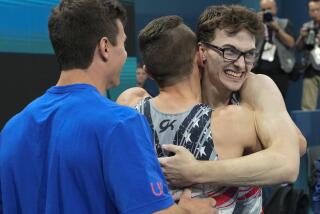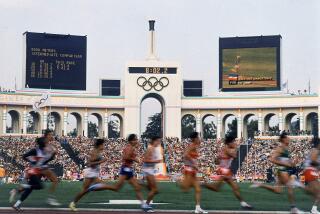One Skill Potential Gladiators Need Is an Ability to Be Humble
They came from as far away as Sacramento to compete for a chance to do battle against a Gladiator on the Saturday morning television series “American Gladiators.”
The show, an hourlong display of David trying to slay Goliath, seemingly ridiculous to some, is for others no different than watching the Dodgers battle the Braves.
In a series of games with names like Assault, The Joust, Hang Tough and The Eliminator, contenders must maneuver past the Gladiators without getting knocked down, beaten up or pummeled with things like tennis balls or pugil sticks. In The Joust, the contender uses what looks like a giant Q-Tip, actually a 7-foot pugil stick, to try to knock the Gladiator off a seven-foot-high platform.
Last Sunday, about 1,000 self-described gym rats and fitness freaks met a 9 a.m. casting call for the show because “I’m 27 years old, and I’m curious to see what I’m capable of doing,” or “Money--heck no, I just want to see if I could make it,” or “It’s something you have to do. It’s a challenge.”
In the end, the contenders discovered that athletic prowess wasn’t enough. They had to be impressive in front of the camera as well.
The tryouts at CBS Studios in Studio City were part of a nationwide search in six cities for contenders for the show. About a thousand would-be competitors showed up at each location. Many were called but only 80 will be chosen.
Among the crowd who gathered for the tryouts was Lorraine Howard, 35, a mother of five from Monrovia. She was one of many who failed, on the first try, to pass required athletic tests. First there were chin-ups--24 in 30 seconds for the men and seven in 30 seconds for women.
Howard did 6 1/2 in 30 seconds and waited in line for two hours to try again. So did many men who grunted and strained their way to 10, 17, even 23 chin-ups as the stopwatch struck 30. As they waited, they strategized with those who’d made it all the way through on how to beat the bar and the other events. The other events:
* The 40-yard dash, to be run in five seconds or less for men and six seconds for the women. “Don’t even think about getting eliminated, you can do this!” yelled one of the first five contestants to advance to the sprint. When the race was over, he’d missed qualifying by 22 hundredths of a second.
* The rope climb, which proved challenging to winners and losers alike. Some who reached the top of the 20-foot rope in the allotted 10 seconds (for women, a 15-foot rope) descended too fast and suffered rope burns and blisters and oozed blood.
* A test of timed lateral movements wherein competitors ran sideways within an eight-foot radius without crossing their legs.
* Powerball, the finale, which simulated the show event of the same name with slight modifications. Resembling one-on-one basketball meets high school wrestling, two opponents went head to head in a contest where “the show,” not the number of points scored was “the thing!”
“Jukes,” quick fake-out movements that can leave one’s opponent’s butt down on the mat after having tripped over his own feet, count heavily.
For Powerball, contestants donned the protective gear seen on TV--boxing helmets, knee and elbow pads, even mouthpieces. That didn’t help a gymnast whose knee buckled as she tried to juke her opponent. The nurse on hand applied an ice pack, wrapped her knee and arranged for her boyfriend to get her to a nearby hospital.
“I wanted to make it,” she said, sobbing.
For the chosen few, a questionnaire and a screen test followed the competition.
Larri Nolan, 26, of Los Angeles, who wants to be a firefighter, finished the athletic events but was not called to appear before the camera. He seemed unfazed by the rejection.
“I think I did excellent,” Nolan said as he walked to his car. “I did it on the first try. I don’t think I impressed them enough in the Powerball. They’ve got a certain type of look in mind and I guess it wasn’t me.”
When the tests of athleticism are over, the race is not necessarily to the swift or the strong, but to the swift, the strong and those with the right look.
“It’s personality more than how good-looking they are,” said an executive with the show. “We want people who are representative of a cross-section of America.”
Those with the right look were asked how they’d train for their TV appearance and who their heroes were. Penciled in were Earvin (Magic) Johnson, Michael Jordan, Arnold Schwarzenegger, Zig Ziglar, my brother, my dad and my grandma, to name a few.
When Roy Cox, the 27-year-old president of an auto glass company, sat before the show’s executive in charge of production, he was asked to explain his hero choice--his father. “ ‘Cause he’s a good man. You don’t realize it while you’re growing up.”
The producer then asked Cox, a former semipro football player for the Sacramento Steamers and an amateur boxer, why he had tried out.
He said that he was answering a challenge from Laser, a 6-foot-1, 220-pound Gladiator who made it to the pros as a football player. Laser had challenged all the show’s viewers to get off their butts and try out.
At the producer’s prompting, Cox stared into the camera and issued his own challenge: “You better watch out, Laser, ‘cause I’m coming to get you.”
It’s show time, folks!
All this for a shot at a top payout of $35,000 in cash and prizes or perhaps an invitation to become a Gladiator?
For some, yes. For most though, all they wanted was a chance to prove themselves stronger and faster and smarter than the men and women they watch with zeal on Saturday mornings.
“This goes back to dawn of the times,” said Cox.
More to Read
Go beyond the scoreboard
Get the latest on L.A.'s teams in the daily Sports Report newsletter.
You may occasionally receive promotional content from the Los Angeles Times.










